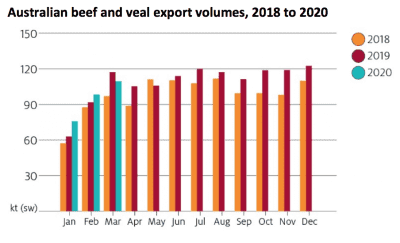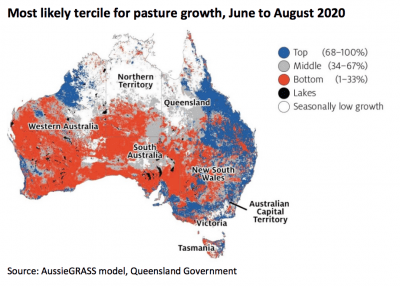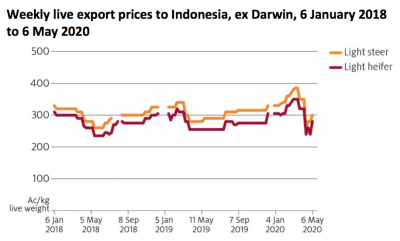SALEYARD prices for cattle are expected to increase by four percent on average over the next 12 months as low supply constrains production and export volumes, according to ABARES’ June quarter outlook report released today.
Prices to remain high as a result of tight supply
The Australian beef cattle herd remains at 30 year low, currently estimated at 21.1 million head, the lowest since 1989-90.
Lower turn-off from the smaller national herd, and cattle being retained for restocking and herd rebuilding, will constrain beef production and exports over the short term.
With gradual restocking over the next 12 months ABARES expects the herd to increase to 21.5 million head by June 2021.
Global demand for beef is described as “robust” in the short term, but COVID-19 has increased uncertainty in export markets.
ABARES expects these factors to lead to a four percent lift in the average saleyard price of steers and cows in 2020–21, to 556 cents per kilogram.
Improved production conditions in many eastern cattle areas
After two years of drought, widespread and above average rainfall earlier in 2020 has led to pasture growth in South Eastern Australia, with models also pointing to above average pasture growth over most of eastern Australia and particularly in Queensland over winter (see above map).
Winter is typically a period of low rainfall and pasture growth and a recovery in pasture biomass in the west and tropical north will still require a more favourable monsoon in the summer of 2020–21.
Production to fall as herd rebuilding gains momentum
Australian beef production is forecast to fall by 17 percent in 2020–21 to 1.9 million tonnes.
A 7 percent fall in the number of cattle slaughtered since February has been partially offset by an increase in average slaughter weights, reflecting the high number of animals in feedlots and a declining share of females.
Female slaughter rates lower than around 47 percent indicate herd rebuilding is taking place. After averaging 56 percent in 2019, female slaughter rates fell to an average of 52pc in the first three months of 2020, and in Queensland averaged just 44 percent between January and May.
Female slaughter rates are expected to continue to fall throughout 2020 as herd rebuilding gains momentum, ABARES predicts.
However, it adds that the pace of herd rebuilding will be limited in some cases by the high price of restocker animals and limited cash flow after years of drought.
Beef export volumes to fall
The volume of beef exports is forecast to fall by 22pc in 2020–21 to 995,000 tonnes, in line with the forecast fall in production.
However, the overall value of beef exports will not fall as significantly due to anticipated increases in export prices.
In contrast to the forecast 22pc fall in export volumes in 2020-21, export value is forecast to fall by 19pc to $8.9 billion (this is down from $11 billion in 2019-20, when overall value of exports was enhanced by drought-related turn-off and high global prices).
Viral impacts
The ongoing shortage of protein as a result of outbreaks of African swine fever in China has continued to support global beef prices.
Data to March 2020 indicates that the overall impact of COVID-19 on Australia’s beef exports has been small, ABARES said.
Average export unit values were 5 percent higher in the first quarter of 2020 compared with the previous quarter, and 16 percent higher than the same quarter last year.
This was partly the result of a lower Australian dollar, which depreciated sharply in March.
ABARES notes that exports of high-value products normally destined for foreign food service channels were disproportionately affected early in the pandemic.
Australia is potentially well positioned because of its low levels of community transmission.
If Australia is able to maintain this status and keep its supply chains functioning efficiently, Australian beef producers may benefit from temporary supply disruptions in competing nations. It could also help Australia build its reputation as a reliable supplier of quality meat.
How exports to key markets are expected to unfold
The volume of beef exports to China is expected to reach 324,000 tonnes in 2019–20, up from 228,000 tonnes last year.
Exports to the United States are forecast to reach 226,000 tonnes in 2019–20, 6pc lower than 2018–19.
Export volumes to other major markets such as Japan and Korea remained relatively unaffected by extensive COVID-19–related restrictions in both countries, with retail sales remaining relatively strong.
Live export volumes to fall 25pc
Live cattle export volumes are forecast to fall by 25pc in 2020–21 to around 900,000 head.
This reflects tighter domestic supply and falling demand as responses to COVID-19 reduce household incomes in importing countries such as Indonesia.
On balance, average export prices are expected to increase slightly as the effect of tightening supplies more than offsets falling demand.
ABARES notes that this forecasts depends on “the uncertain duration and severity of COVID-19 impacts on demand”.
Changes in consumer preferences
Changes in consumer preferences in response to COVID-19 may benefit sales of Australian beef, the ABARES report suggests.
“For example, Chinese consumers have been substituting away from wet markets towards large supermarkets and online sales—distribution channels that favour Australian beef.
“The same consumer trend is evident in Indonesia, but this is leading to an increase in demand for Australian boxed beef, and a decrease in demand for Australian live exports.
“In 2018 Australia accounted for 42pc of Indonesian beef imports (by value and volume), despite intense competition from cost-competitive Indian carabeef.
“Australian beef is typically sold in supermarkets, food service or hotels. Indian carabeef is typically sold in wet markets, to bakso (meatball) manufacturers or in food service.”
Tight profit margins for feedlot industry
After reaching a record high number of animals in feedlots at the end of 2019, the number of animals on feed fell by 12[c in the March quarter of 2020.
Rapid pasture growth in the autumn of 2020 increased saleyard prices for feedlotters who are competing with restockers for a relatively small supply of animals.
At the same time, responses to COVID-19 have increased uncertainty in beef markets, and reduced returns for the high-quality grain-fed cuts favoured by export markets.
The number of animals on feed is likely to continue to fall in 2020–21, ABARES expects.
The report also noted the suspension of four major abattoirs from the Chinese market, but said it is still unclear how long these suspensions will last.
To view the full ABARES June 2020 report on the DAWE website click here



